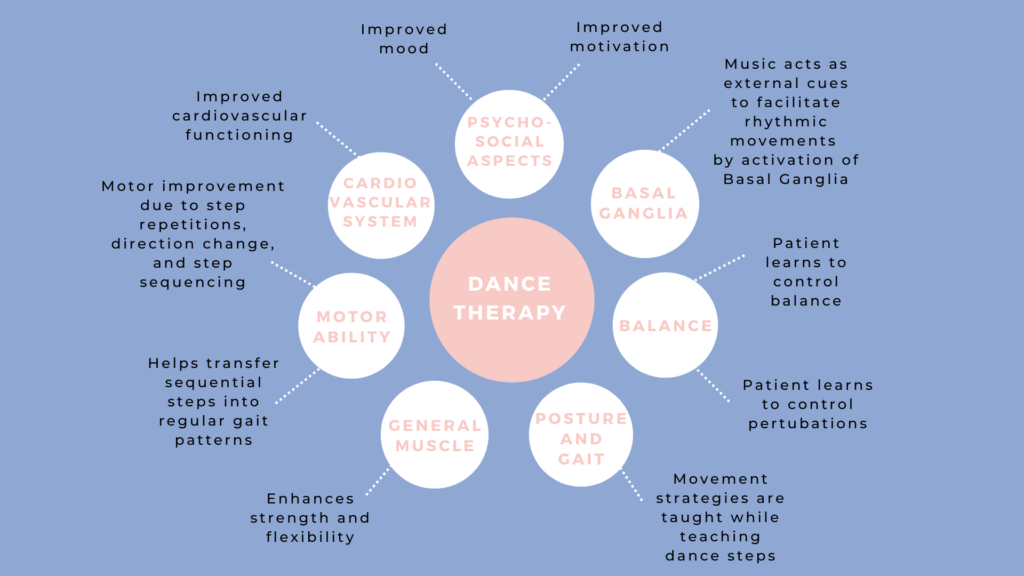Are there no falls with Dancing? : Dance Therapy and Cognitive Exercises in patients with Lumbar spinal stenosis
Written by Nirja Shah
Share this article
Key points
- Evaluation of the effect of dance therapy and cognitive exercise vs. physical therapy on gait and physical function
- No changes in pain perception and ability to perform activities of daily living
- Reduced variability in normal stride to stride
- Reduced fear of falling
Abstract
This study compares the effects of a multimodal movement intervention (coordinative–cognitive exercises and dancing program) with standard physical therapy on gait, physical function, and quality of life in 60-80 year-old patients with lumbar spinal stenosis over a six week trial period. The primary outcome measures used for analysis were Minimum toe clearance (MTC), double step length (DSL) variability, and the Timed “Up & Go” test (TUG). The secondary outcome measures used were the Brief Pain Inventory, the short Fall Efficacy Scale–International (sFES-I), and the Oswestry Disability Index.
The authors concluded that the Multimodal Intervention group had significantly lower MTC variability than the PT group which signifies a low variability in the normal gait stride. There were no changes observed in DSL in this group. The Multimodal Intervention group reported an improved TUG and a reduced sFES-I. This decreased MTC variability and fear of falling and enhanced functional mobility may reduce the risk of falling.
Introduction
Previous research suggests that multimodal exercise interventions that incorporate coordinative and cognitive elements significantly impact plasticity and cognitive functions than single modality interventions. This could be due to a combination of indirect mechanisms such as increased cardiovascular fitness, muscle mass, muscle strength and direct mechanisms such as task-specific neuroplasticity.
As a result, a dance training that combines complex sensorimotor, rhythmic, and physical activity with multiple cognitive and social elements, as well as a coordinated–cognitive demanding training, may have superior effects on designated cognitive functions, resulting in decreased gait variability.[1],[2].[3] Reduced gait variability may reduce the risk of trip-related falls in people with chronic low back pain.
The Study Design
Previous studies have used multimodal approaches such as pilates and belly dancing, and they have shown a reduction in fear of falling and improvement in functional mobility. This study utilizes cognitive exercises and a dance program given-
Twice a week for 60 minutes over six weeks to 24 participants.
They were then observed for pre and post-test changes using outcome measures like:
- Minimum Toe Clearance (MTC)
- Double Step Length (Dsl) Variability
- The Timed “Up & Go” Test (TUG)
- Brief Pain Inventory
- The Short Fall Efficacy Scale–international (Sfes-i)
- The Oswestry Disability Index
The authors found no difference in pain perception (BPI) or pain-related disabilities in performing activities of daily living (ODI) for either group.
Furthermore, they discovered a group effect, indicating MTC variability was significantly lower in the Multimodal Intervention group than the PI group at the end of the intervention. The DSL variability had remained constant. They also observed a time effect, indicating that gait variability (DSL and MTC) was slightly reduced in subjects who had completed the Multimodal Intervention.
No statistically significant time effects were noted for either group. However, a trend was observed for the Multimodal Intervention group, indicating that these subjects reduced their DSL and MTC variability in the post-test.

In the Multimodal Intervention group, there was a significant time effect for the sFES-I, demonstrating that fear of falling is reduced after 6 weeks of intervention. The sFES-I, on the other hand, did not change over time in the PT group.
Limitations
- Limited sample size
- Absence of a detailed clinical assessment for gait-related parameters
- This six week trial period does not effectively demonstrate the long term effects of a multimodal approach
Conclusion
A Multimodal Intervention approach comprising of dance therapy has been known to:

- Increase Strength
- Flexibility
- Decrease muscle tension
- Boost the patient’s coordination in many different pathologies
Should be considered as a part of our toolkit along with our other standardized exercises to alleviate the fear of falling while walking and making their path to recovery more enjoyable.
References
1. This is a paper review for the article cited -. “Effect of a Multimodal Movement Intervention in Patients With Neurogenic Claudication Based on Lumbar Spinal Stenosis and/or Degenerative Spondylolisthesis-A Pilot Study.” Frontiers in medicine vol. 7 540070. 8 Dec. 2020, https://doi.org/10.3389/fmed.2020.540070 Received-2020 Mar 18; Accepted- 2020 Oct 14, Published-08 December 2020.This article is licensed under a Creative Commons Attribution 4.0 International License, which permits use, sharing, adaptation, distribution, and reproduction in any medium or format, as long as you give appropriate credit to the original author(s) and the source, provide a link to the Creative Commons license, and indicate if changes were made.
2. Levin O, Netz Y, Ziv G. The beneficial effects of different types of exercise interventions on motor and cognitive functions in older age: a systematic review. Eur Rev Aging Phys Act. (2017) 21:20. doi: 10.1186/s11556-017-0189-z
3. Netz, Y. (2019). Is there a preferred mode of exercise for cognition enhancement in older age?-a narrative review. Front. Med. 6:57. doi: 10.3389/fmed.2019.00057
4. Herold F, Hamacher D, Schega L, Müller NG. Thinking while moving or moving while thinking – concepts of motor-cognitive training for cognitive performance enhancement. Front Aging Neurosci. (2018) 10:228. doi: 10.3389/fnagi.2018.00228
Contributors

NIRJA SHAH
Research & Content Writing Team

RIA GOREY
Multimedia Team
